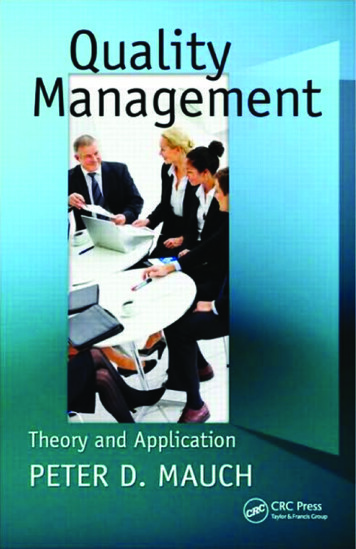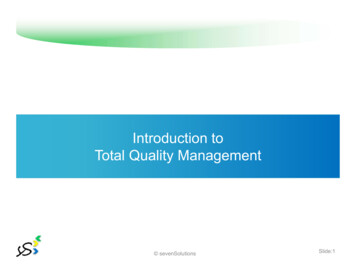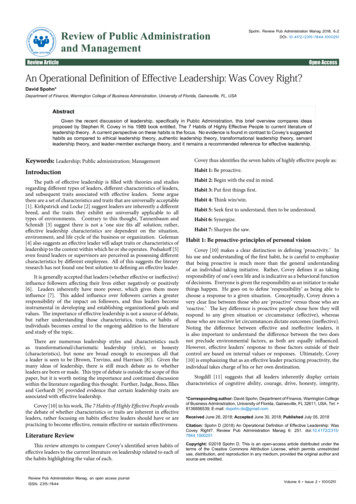
Transcription
QualityManagementTheory and ApplicationPETER D. MAUCH 2010 by Taylor and Francis Group, LLC
CRC PressTaylor & Francis Group6000 Broken Sound Parkway NW, Suite 300Boca Raton, FL 33487-2742 2010 by Taylor and Francis Group, LLCCRC Press is an imprint of Taylor & Francis Group, an Informa businessNo claim to original U.S. Government worksPrinted in the United States of America on acid-free paper10 9 8 7 6 5 4 3 2 1International Standard Book Number: 978-1-4398-1380-5 (Hardback)This book contains information obtained from authentic and highly regarded sources. Reasonable effortshave been made to publish reliable data and information, but the author and publisher cannot assumeresponsibility for the validity of all materials or the consequences of their use. The authors and publishershave attempted to trace the copyright holders of all material reproduced in this publication and apologizeto copyright holders if permission to publish in this form has not been obtained. If any copyright materialhas not been acknowledged please write and let us know so we may rectify in any future reprint.Except as permitted under U.S. Copyright Law, no part of this book may be reprinted, reproduced, transmitted, or utilized in any form by any electronic, mechanical, or other means, now known or hereafterinvented, including photocopying, microfilming, and recording, or in any information storage or retrievalsystem, without written permission from the publishers.For permission to photocopy or use material electronically from this work, please access www.copyright.com (http://www.copyright.com/) or contact the Copyright Clearance Center, Inc. (CCC), 222 RosewoodDrive, Danvers, MA 01923, 978-750-8400. CCC is a not-for-profit organization that provides licenses andregistration for a variety of users. For organizations that have been granted a photocopy license by theCCC, a separate system of payment has been arranged.Trademark Notice: Product or corporate names may be trademarks or registered trademarks, and areused only for identification and explanation without intent to infringe.Library of Congress Cataloging-in-Publication DataMauch, Peter D., 1954Quality management : theory and application / Peter D. Mauch.p. cm.Includes bibliographical references and index.ISBN 978-1-4398-1380-5 (hardcover : alk. paper)1. Total quality management. 2. Quality control. I. Title.HD62.15.M377 2009658.4’013--dc22Visit the Taylor & Francis Web site athttp://www.taylorandfrancis.comand the CRC Press Web site athttp://www.crcpress.com 2010 by Taylor and Francis Group, LLC2009042044
DedicationThis book is dedicated to those quality professionals, past, present, andfuture, who seek to advance the quality sciences through traditionaleducation and scientific research. This book is also dedicated to myclose friends and family members, who gave and did not take, builtand did not destroy. Especially to my wife Julie, who believed in me.v 2010 by Taylor and Francis Group, LLC
EpigraphThe ThinkerBack of the beating hammerBy which the steel is wrought,Back of the workshop’s clamorThe seeker may find the Thought—The Thought that is ever masterOf iron and steam and steel,That rises above disasterAnd tramples it under heel!The drudge may fret and tinkerOr labor with lusty blows,But back of him stands the Thinker,The clear-eyed man who knows;For into each plow or saber,Each piece and part and whole,Must go the Brains of Labor,Which gives the work a soul!Back of the motors humming,Back of the belts that sing,Back of the hammers drumming,Back of the cranes that swing,There is the eye which scans themWatching through stress and strain,There is the Mind which plans them—Back of the brawn, the Brain!Might of the roaring boiler,Force of the engine’s thrust,Strength of the sweating toiler—Greatly in these we trust.But back of them stands the Schemer,The thinker who drives things through;Back of the Job—the DreamerWho’s making the dreams come true!Berton Braleyvii 2010 by Taylor and Francis Group, LLC
ContentsList of Figures.xviiList of Tables.xixPreface.xxiChapter 1 Organizing for Quality. ng Duties.2Leadership.3Product or Service Producing.3Support.4Incongruence.4Breaking Categories into Classifications.5Leadership Classifications.5Product- or Service-Producing Classifications.5Support Classifications.6Basic Functional Structure.6Quality Function Considerations.7Authority, Accountability, and Responsibility.8Authority Principles.9Revise and Adjust.9Communication.10Summary.10Review Questions.10Chapter 2 Planning for Quality. ss Quality Planning.15Elements of an Effective Quality System.15ix 2010 by Taylor and Francis Group, LLC
x ContentsMarketing.15Setting Objectives.15Long- and Short-Range Objectives.17Setting Business Metrics.19Process Quality Planning.19General Information. 20Details. 20Failure Modes.21Control.22Project Planning.24General Information.24Status Reporting.26Detail.26Product Quality Planning.26General Information.26Detail.27Product Verification and Validation Planning. 28Responsibility and Interfaces. 28Information Accessibility. 28Files and Records.29Validation Facilities.29Validation Personnel. 30Validation Procedures. 30Scheduling and Revising Validation Plans. 30Policies, Procedures, and Objectives. 30Policies.31Procedures and Rules.32Forms and Records.32Blueprints (Product Specifications).33Process Flowcharting.33Standardization of Symbols.35Normal Logic Flow.35Process Flow.35Communication.36Summary.36Review Questions.37 2010 by Taylor and Francis Group, LLC
Contents xiChapter 3 Controlling for Quality. 39Objectives.39Terminology.39Introduction. 40Long-Range Objectives. 40Short-Range Objectives. 40A Cascade Approach.41Concerns of Control.41Written Reports. 42Preparing Reports. 42Correcting for Deviations. 42Importance of Value. 42Basic Concepts. 43Organizational Responsibility. 43The Role of Quality Management.45Introduction to Quality-Reporting Basics.45The Business Quality Report. 46Underlying Concepts. 48Activity Reporting.49Journalizing Procedure.51Posting. 54Product Performance Reporting.55Analysis. 56Ranked Order Analysis. 56Fishbone Diagram.57Controlling Nonconformance Identification.58Identification during Work.58Completion of Work.58Inspection.58Identification of Nonconforming Product.58Segregation.58Short-Run Production.58Long-Run Production.59Risk.59Disposition.59Responsibilities for Disposition.59 2010 by Taylor and Francis Group, LLC
xii ContentsCorrective and Preventive Action (CAPA) Methodology. 60Immediate Action Required. 60Magnitude of the Nonconformity. 60CAPA Methodology. 60Summary.61Review Questions.62Chapter 4 Staffing for Quality. 63Objectives.63Terminology.63Forecasting Human Resources Needs. 64Job Descriptions.67Job Analysis.67Methods. 68Results.69Position Requirement.69Education and Training.70Systems of Formal Education.70Primary Education.70Secondary Education.71Higher Education.71Adult Education.72Alternative Education.72Training.73Training Records.74Summary.76Review Questions.76Chapter 5 Motivating for Quality. 77Objectives.77Terminology.77Lead, Coach, and Guide.78Leadership 2 2010 by Taylor and Francis Group, LLC
Contents xiiiLaissez-Faire.82Rewards Based upon Performance.82Praise and Censure Fairly.83Performance Appraisals.83Provide a Motivating Environment.85Deficiency Needs.85Physiological Needs.85Safety Needs. 86Social Needs.87Esteem Needs.87Self-Actualization. 88Summary. 90Review Questions.91Chapter 6 Special Topics in Quality. 93Overview of Statistical Methods.93History.93Overview.94Statistical Methods.95Experimental and Observational Studies.95Levels of Measurement.97History of SPC.102General.102Risk Analysis.106Risk Analysis and the Risk Workshop.107Facilitated Risk Analysis Process.109Reliability Engineering.110Reliability Theory.110Reliability Program Plan.111Reliability Requirements.111System Reliability Parameters.112Reliability Modeling.112Reliability Test Requirements.113Requirements for Reliability Tasks.114Design for Reliability.115Fault Tree Diagrams.115Reliability Testing.116 2010 by Taylor and Francis Group, LLC
xiv ContentsA Reliability Sequential Test Plan.116Accelerated Testing.118Software Reliability.118Reliability Operational Assessment. 120Reliability Organizations.121Certification.121Reliability Engineering Education. 122Systems Analysis. 122Characterization of Systems. 122LTI Systems.125Auditing.125Audit Planning and Scheduling. 126Auditor Education and Training. 126Audit Initiation. 126Audit Scope. 126Audit Objective. 126Frequency and Timing. 128Long-Term Planning. 128Pre-Audit Review of System. 128Working Papers. 128Result. 128Sampling Plans. 128Audit Implementation Steps.130Notification to Auditee.131Opening Meeting.131Information, Verification, and Evaluation.131Audit Observations.131Audit Supervision.132Audit Follow-Up.132Preparation of the Report.132Content of the Report.132Reporting the Audit.132Review and Distribution.132Audit Completion.133Record Retention.133Cost of Quality.133Origins. 134 2010 by Taylor and Francis Group, LLC
Contents xvAppendix A: Business Quality Plan. 137Appendix B: Process Quality Plan. 139Appendix C: Product Quality Plan. 141Bibliography. 143 2010 by Taylor and Francis Group, LLC
List of FiguresFigure 1.1Product- or service-producing activities.3Figure 1.2Support activities.4Figure 1.3Line and staff organization.7Figure 2.1 Interaction of objectives, policy, and procedures.31Figure 2.2 The quality-planning process.36Figure 3.1 Business quality report.47Figure 3.2Performance diagram. 48Figure 3.3 Reporting flow.50Figure 3.4 Basic activity report.51Figure 3.5 Posting to the business quality report.55Figure 3.6 Fishbone diagram.57Figure 4.1Organizational breakdown of positions.70Figure 4.2 Employee training record.75Figure 6.1 Normal curve.103Figure 6.2 Audit plan and report.127Figure 6.3 Audit working paper.129Figure 6.4C 0 sampling plan.130Figure 6.5 Audit steps: Any process.131xvii 2010 by Taylor and Francis Group, LLC
List of TablesTable 1.1Responsibility Matrix.8Table 2.1Formal versus Informal Planning.14Table 2.2QMS Responsibility Matrix.16Table 2.3Business Quality Plan.18Table 2.4Process Quality Plan: General Information. 20Table 2.5Process Quality Planning: Partial Detail.21Table 2.6Process Quality Planning: Failure Modes.22Table 2.7Process Quality Planning: Control.23Table 2.8Project Planning: Gantt Chart.25Table 2.9Product Quality Plan.27Table 2.10 Flowcharting Symbols. 34Table 2.11 Basic Process Flows.35Table 3.1Ranked Order Analysis. 56Table 4.1Personnel Forecasting. 66Table 5.1Maslow and Herzberg Comparison. 90Table 6.1Statistical Formulas.98Table 6.2Statistical Methods Applied to Operations.104Table 6.3SPC Constants.104Table 6.4Quality-Engineering Formulas.105Table 6.5Statistical Sampling Plan.106Table 6.6Cost-of-Quality Statement. 134xix 2010 by Taylor and Francis Group, LLC
PrefaceThe rise of the quality profession as a specialty within business coincidedwith the increased complexity of business enterprises. In simpler times,when goods and services were provided by individual artisans, elaboratequality systems were unnecessary. An individual producer could simplycompare customer requirements to his or her work and estimate its value.The rise of complex and large enterprises produced the need for thedevelopment of objective and equitable quality procedures for the determination of value so the owners could assure the efficiency of their operations. Traditional quality management concerned itself with developingprocedures to determine product conformance or nonconformance(inspection).Unfortunately, in too many cases, the study of (inspection) procedures became an end in itself. Businesses lost sight of the objectives ofthe procedures. “Acceptable” techniques were applied whether they wereappropriate or not. This in turn led to criticism of quality managementas a discipline that provided a great deal of largely irrelevant data tomanagement.Fortunately, the discipline is changing. Quality professionals are becoming much more concerned with providing information that will helpmanagement meet the firm’s goals. In this book, I hope to continue themovement toward consideration of the objectives of quality managementand value reporting.In quality management, fairness and objectivity play an almost equalrole with relevance in the determination of the appropriate quality procedures. The American National Standards Institute (ANSI) specifiesactivities that must be followed as generally accepted quality principlesand practices (GAQP) known as ISO 9000. In some cases, the opinionsof groups with regard to these practices are backed only by the acceptedstature of the promulgating organizations, whereas in others, the imposedrequirements carry the weight of law behind them. In nearly every case,the intent of the suggested (or required) practice is to promote fairness inquality and the reporting of quality performance information to a diversemanagement audience.xxi 2010 by Taylor and Francis Group, LLC
xxii PrefaceA quality management system (QMS) is a performance-reporting systemand is defined as a formal system of accumulating and reporting data usefulfor the achievement of management’s objectives. Whether we are concernedwith a not-for-profit institution or any other organization, there are generalcharacteristics that the performance-reporting system must possess. In thefollowing chapters, we will explore the implementation and application of aquality management system. 2010 by Taylor and Francis Group, LLC
1Organizing for QualityObjectives1. To introduce the quality organization function.2. To discuss the quality management delegation process.3. To present different quality organizational structures.TerminologyAttribute: A characteristic inherent in or ascribed to something.Authority: The right to command and expend resources.Category: A group of similar classifications that contain the same( multiple) attributes.Centralized organization: An organization in which little or no authorityis delegated.Classification: A group of items in a category that contain the same(single) attribute.Management: A process or form of work that involves the guidanceor direction of a group of people toward organizational objectives,goals, or requirements.Organization: People working together in groups to attain objectives.Organizing: Categorizing and classifying activities, under a manager,necessary to attain objectives.1 2010 by Taylor and Francis Group, LLC
2 Quality Management: Theory and Application Performance measurement: The use of statistical evidence to determineprogress toward specifically defined organizational objectives, goals,or standards.Quality: Meeting customer needs.Responsibility: Accountabi
v Dedication This book is dedicated to those quality professionals, past, present, and future, who











